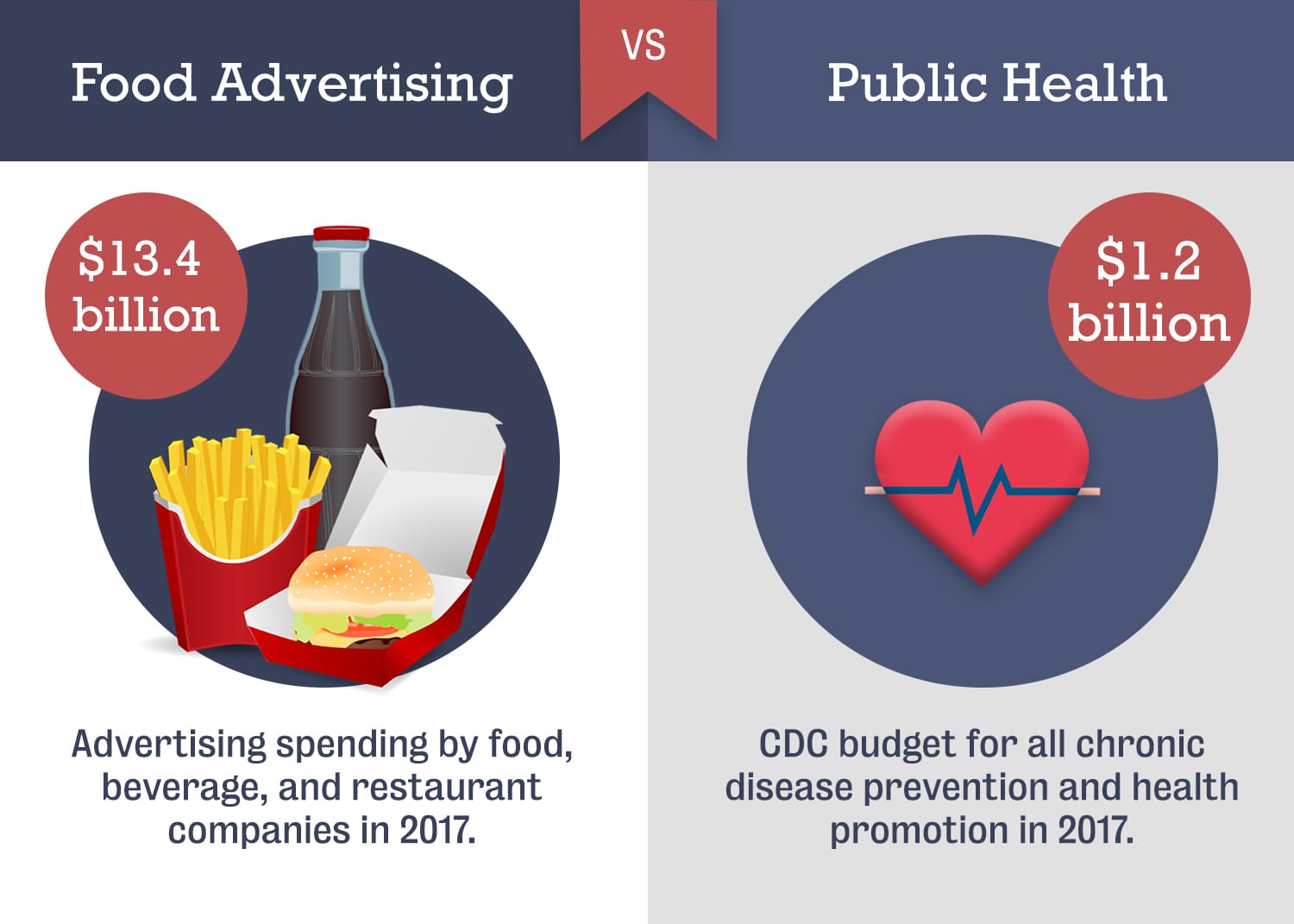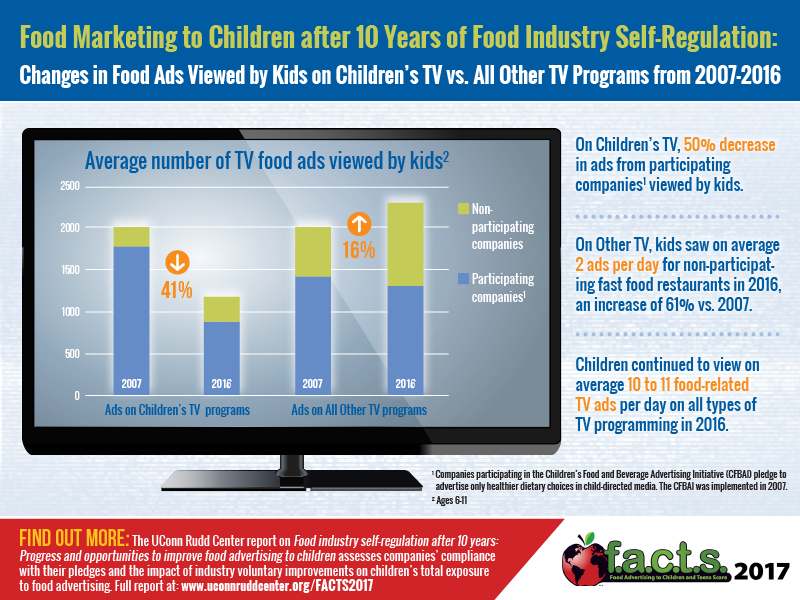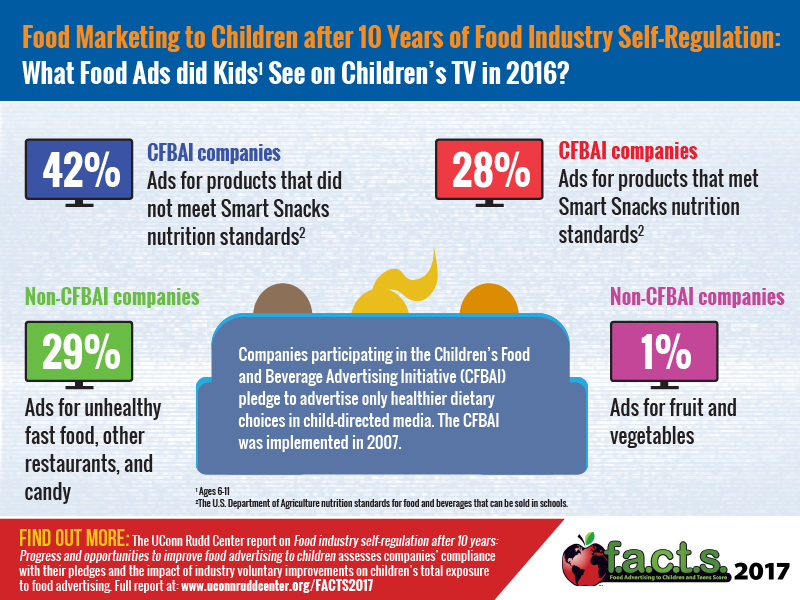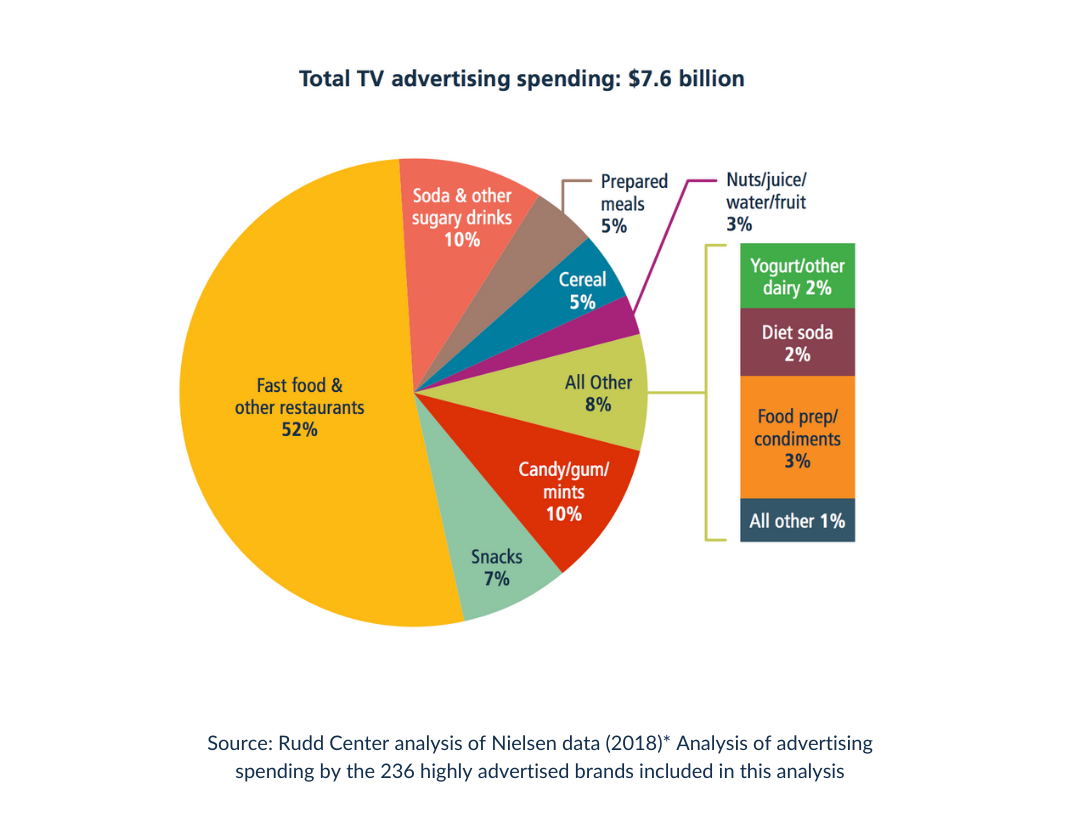TV & Digital Media
Although time spent watching TV among children and teens has declined, television remains the primary source of exposure to food advertising. Food companies continue to devote approximately 85% of their advertising budgets to TV, totaling $11 billion annually. Food companies also engage in targeted marketing to children and teens through product placements during TV programming.
The downward trend in TV viewing among youth has been accompanied by an increase in the time they spend online, especially on social media (e.g., Facebook, Twitter, Instagram, TikTok, and YouTube) via mobile devices. Food companies have responded to this trend by pioneering marketing to young people with ads placed on social media; company-generated posts shared virally through followers’ social networks; branded games and ordering apps for smartphones; and paid promotions from bloggers, influencers, and brand ambassadors. Now, food and beverage brands reach children and teens anytime, anywhere with marketing that is often disguised as entertainment.
Learn More About TV & Digital Marketing
TV Advertising Research
- Harris, J. L., Khanal, B., Fleming-Milici, F., & Andreyeva, T. (2025b). Children’s cereal purchases by U.S. households: Associations with Child Versus Adult TV ad exposure. American Journal of Preventive Medicine. https://doi.org/10.1016/j.amepre.2024.11.022
- Jensen, M. L., Fleming-Milici, F., & Harris, J. L. (2023). Are US food and beverage companies now advertising healthy products to children on television? An evaluation of improvements in industry self-regulation, 2017–2021. International Journal of Behavioral Nutrition and Physical Activity, 20(1), 118.
- Harris J, Sacco S, Fleming-Milici F. TV exposure, attitudes about targeted food ads and brands, and unhealthy consumption by adolescents: Modeling a hierarchical relationship.pdf. Appetite. 2022, ISSN 0195-6663.
- Trends in TV advertising: 2017 update reports food-related TV advertising viewed by children and teens from 2002 to 2017. Brief Report. May 2018.
- Each FACTS Report includes a detailed section on television advertising spending and exposure for the category (including cereal, sugary drinks, fast food, and snacks).
- Fleming-Milici, F., & Harris, J.L. (2018). Television food advertising viewed by preschoolers, children and adolescents: contributors to differences in exposure for black and white youth in the United States. Pediatric Obesity, 13, 103-110.
- Frazier Willie CI, Harris JL. (2018) Trends in Television Food Advertising to Young People: 2017 Update. Brief Report.
- Harris, J.L., & Kalnova, S. (2017). Food and beverage TV advertising to young children: Measuring exposure and potential impact. Appetite.
- Elsey, J. & Harris, J.L. (2016). Trends in food and beverage television brand appearances viewed by children and teens from 2009 to 2015. Public Health Nutrition, 19(11), 1928-1933.
- Harris, J.L., LoDolce, M.E., Dembek, C., & Schwartz, M.B. (2015). Sweet promises: Candy advertising to children and implications for food industry self-regulation. Appetite, 95(1), 585-592.
- Fleming-Milici, F., Harris, J.L., Sarda, V., & Schwartz, M.B. (2013). Amount of Hispanic youth exposure to food and beverage advertising on Spanish- and English-language television. JAMA Pediatrics, 167(8), 723-730.
- Harris, J.L., Sarda, V., Schwartz, M.B., & Brownell, K.D. (2013). Redefining “child-directed advertising” to reduce unhealthy television food advertising. American Journal of Preventive Medicine, 44(4), 358-364.
- Where children and adolescents view food and beverage ads on TV reports exposure by channel and program. Rudd Report. March 2013.
Digital Media Research
- Fleming-Milici, F., Gershman, H., Agresta, H. O., McCann, M., & Harris, J. L. (2025). Young Children’s (3-8y) food and beverage brand exposure on YouTube and YouTube kids: An observational study and content analysis. Journal of the Academy of Nutrition and Dietetics. https://doi.org/10.1016/j.jand.2025.05.010
- Harris, J. L., Fleming-Milici, F., Gearhardt, A. N., Grier, S., Montgomery, K., Romo-Palafox, M., & Tatlow-Golden, M. (2025). Digital Food Marketing and Children’s Health and Well-being. In D. A. Christakis & L. Hale (Eds.), Handbook of Children and Screens: Digital Media, Development, and Well-Being from Birth Through Adolescence. Springer. https://link.springer.com/book/10.1007/978-3-031-69362-5
- Jensen, M. L., Fleming-Milici, F., & Harris, J. L. (2023). Are U.S. Food and beverage companies now advertising healthy products to children on television? an evaluation of improvements in industry self-regulation, 2017–2021. International Journal of Behavioral Nutrition and Physical Activity, 20(1).
- Fleming-Milici, F, Phaneuf, L, Harris, J. (2023). Prevalence of food and beverage brands in “made-for-kids” child-influencer YouTube videos: 2019–2020. Pediatric Obesity, e13008.
- Emond J, Fleming-Milici F, McCarthy J, et al. (2020). Unhealthy Food Marketing on Commercial Educational Websites: Remote Learning and Gaps in Regulation. Am J Prev Med, 2021;60(4):587-591.
- Fleming-Milici F, Harris J. (2019). Adolescents' Engagement with Unhealthy Food and Beverage Brands on Social Media. Appetite, 146(2020), 1-8.
- Hyary, M. & Harris, J.L. (2018). Hispanic youth visits to food and beverage company websites. Health Equity, 1(1), 134-138.
- Ustjanauskas, A., Harris, J.L., & Schwartz, M.B. (2014). Food and beverage advertising on children’s websites. Pediatric Obesity, 9(5), 362-372.
- Cheyne, A., Bukofzer, E., Dorfman, L., & Harris, J.L. (2013). Marketing sugary cereals to children in the digital age: A content analysis of 17 child-targeted websites. Journal of Health Communication, 18(5), 563-582.
- Harris, J.L., Speers, S.E., Schwartz, M.B., & Brownell, K.D. (2012). U.S. food company branded games on the internet: Children’s exposure and effects on snack consumption. Journal of Children and Media, 6(1), 51-68.



